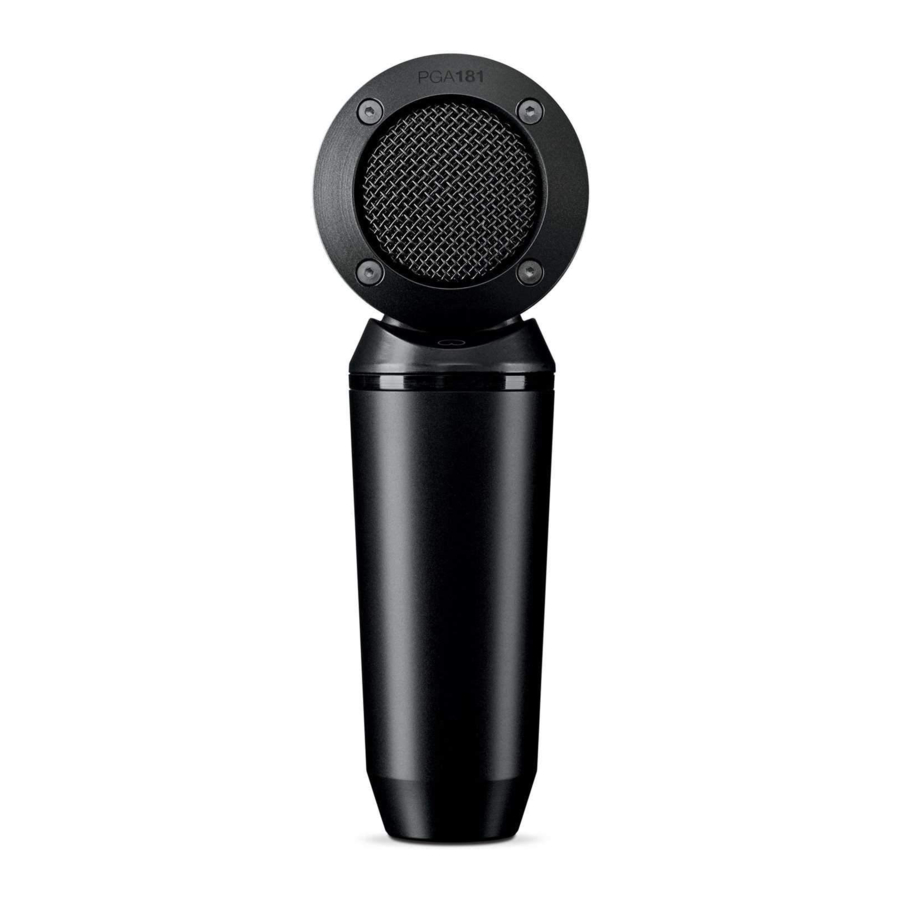
Shure PGA181 - Side-Address Cardioid Condenser Microphone PG Alta Series Manual
- User manual (8 pages) ,
- User manual (56 pages)
Advertisement

Introduction
Congratulations on the purchase of a new Shure PG Alta series microphone. The PG Alta series delivers professional quality audio at an affordable price, with solutions for capturing nearly any source, including voice, acoustic instruments, drums, and amplified electric instruments. Suitable for live and studio applications, PG Alta microphones are built to last, and meet the same rigorous quality testing standards that make all Shure products trustworthy and reliable.
General Rules for Use
- Do not cover any part of the microphone grille with your hand, as this will adversely affect microphone performance.
- Aim the microphone toward the desired sound source (such as the talker, singer, or instrument) and away from unwanted sources.
- Place the microphone as close as practical to the desired sound source.
- Work close to the microphone for extra bass response.
- Use only one microphone to pick up a single sound source.
- For better gain before feedback, use fewer microphones.
- Keep the distance between microphones at least three times the distance from each microphone to its source ("three to one rule").
- Place microphones as far as possible from reflective surfaces.
- Add a windscreen when using the microphone outdoors.
- Avoid excessive handling to minimize pickup of mechanical noise and vibration.
Connecting to a Mixer or Computer
Cables
Use only balanced (three-conductor) cables. Otherwise, the cable will not carry phantom power to the microphone. If using an adapter for 6.5mm (1/4") inputs, it must have tip-ring-sleeve (TRS) contacts.
Computer

Connecting to a computer using the Shure MVi audio interface
To deliver audio directly to a computer, use a USB audio interface with an XLR microphone input that provides +48V phantom power, such as the Shure MVi.
Mixer

When connecting to a mixer, use only balanced, microphone-level inputs with phantom power. Most mixers have a switch for phantom power, so make sure phantom power is on for that channel.
Phantom Power
All condenser microphones require phantom power to operate. This microphone performs best with a 48 V DC supply (IEC61938), but it can operate with lower voltages.
Phantom power is provided by the mixer or audio interface that the microphone is connected to, and requires the use of a balanced microphone cable: XLR-to-XLR or XLR-to-TRS. In most cases, there is a switch or button to activate the phantom power. See the user guide for the mixer or interface for additional information.
Positioning the Microphone

The front of the microphone is marked by several indicators: four screws around the grille, the cardioid logo, and the PGA181 model number. Position this side toward the sound source.
Applications
The following table provides a basic starting point for several instruments. Shure offers additional educational publications on microphone placement and recording techniques. Visit www.shure.com for more information.
| Application | Distance from source | Tips |
| Voice | 1-3 inches (2-8 cm) | Use a pop filter (Shure PS-6) to prevent plosives. |
| Acoustic guitar | 6-12 inches (15-30 cm) | Place near the sound hole for a full sound, or near the 12th fret for a balanced, natural sound. |
| Drums | 3-6 feet (1-2 m) | Place in front of the drum kit to capture more of the kick drum, or as an overhead (above the kit, facing down) to capture more cymbals. Consider using additional Shure microphones placed on individual drums for more mixing flexibility and a thicker sound. |
| Amplifiers | 1-6 inches (2-15 cm) | Aim towards the center of the speaker for a clear, aggressive sound, or towards the edge of the speaker for a mellow sound. |
| Strings or horns | 1-6 feet (30 cm - 2 m) | For a single instrument, place the microphone close to the source. For a horn or string section, arrange players at an equal distance from the microphone. |
| Full band | 3-10 feet (1-3 m) | Face the microphone towards the group, centered between instruments. |

Optional Accessories and Replacement Parts
| 7.6 m (25 ft.) Cable (XLR-XLR) | C25J |
| 5/8" to 3/8" Thread Adapter | 31A1856 |
| 4.6 m (15 ft.) Cable (XLR-XLR) | 95D2153 |
| Wireless Microphone Clip | WA371 |
| Popper Stopper® Pop Filter with Metal Gooseneck and Microphone Stand Clamp | PS-6 |
| Foam Windscreen for all larger Shure "ball-type" Microphones available in black, blue, gray, green, red and yellow | A58WS |
Specifications
Type
Electret Condenser
Polar Pattern
Cardioid
Frequency Response
50 to 20,000 Hz
Output Impedance
at 1 kHz, open circuit voltage
120 Ω, actual
Sensitivity
at 1 kHz, open circuit voltage
-38 dBV/Pa [1] (12.7 mV)
-
[1] 1 Pa=94 dB SPL
Maximum SPL
1 kHz at 1% THD, 1 kΩ load
138 dB SPL
Polarity
Positive pressure on diaphragm produces positive voltage on pin 2 with respect to pin 3
Connector
Three-pin professional audio (XLR), male
Weight
383 g (0.8 lbs)
Housing
Cast Zinc
Power Requirements
48 V DC phantom power (4 mA)
Frequency Response

Polar Pattern

Dimensions


Documents / Resources
References
Download manual
Here you can download full pdf version of manual, it may contain additional safety instructions, warranty information, FCC rules, etc.
Download Shure PGA181 - Side-Address Cardioid Condenser Microphone PG Alta Series Manual
Advertisement




















Need help?
Do you have a question about the PGA181 and is the answer not in the manual?
Questions and answers